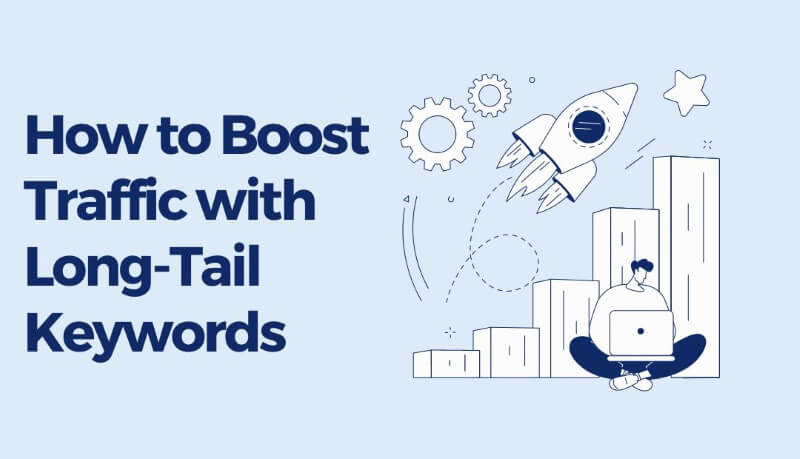How to Boost Traffic with Long-Tail Keywords

If you’ve had a blog or website for very long, by now you probably know 2 important things about search engine optimization:
- a lot of keywords that seem perfect are too competitive, so they don’t bring in much traffic
- loads of visitors mean absolutely nothing without conversions
The trick to a successful website is twofold: first, you need to attract plenty of visitors, and second, you have to convince them to convert into readers, subscribers, and buyers. With the right strategy, you can achieve both goals and make your SEO do double-duty. The key is to use long-tail keywords.
What are long-tail keywords, anyway?
These search queries are phrases used to search for very specific products or information. While “blog writing” is short and generic, for example, “blog writing for dummies” is more specific and much more likely to lead to a conversion.
Long-tail key phrases are sometimes a forgotten gold mine of opportunity in SEO strategies because they don’t generate a lot of traffic individually. Their search volume is much lower than more generic search terms, so the number of visitors these keywords can attract to your site is correspondingly lower.
How Long-Tail Key Phrases Boost Your Traffic
However, smaller traffic per keyword can actually work in your favor. If you optimize every page and post on your website for at least one long-tail keyword, all those smaller search volumes eventually add up to sizable traffic. Competitive core keywords only make up about 18% of all search traffic, while all the long-tails combined accounts for 70% of all search traffic.

These key phrases also build up your relevance for generic core keywords that are naturally more competitive. The more relevant you become for those keywords, the higher you rank for them, earning you better rankings and more traffic over time.
Getting more traffic with these specialized keywords is always a good thing. But the number one reason to use long-tail key phrases is their potential for conversion.
How Long-Tail Keywords Boost Your Conversions
Specific search phrases show you exactly what your audience wants, which SEOs call “user intent.” When you know what your users want, you can tailor your products, pages, and posts to deliver what they want. So when searchers land on your website and find exactly what they’re looking for, they’re far more likely to subscribe, buy, or otherwise convert.
Users who search with long-tail keywords are already near the end of the buying cycle. They’re mostly done researching. They don’t want pictures or reviews or more information. They’re ready to take action.
Because these visitors to your website are so much closer to the end of the sales funnel, it’s much easier to turn them into subscribers or buyers. You don’t have to waste time courting them or figuring out what they want. They know what they want, they’re ready to act, and you offer what they want.
With all these traffic, conversion, and audience research benefits, long-tail keywords used effectively are a match made in heaven.
How to Find the Best Long-Tail Search Phrases
Most reputable keyword tools will deliver long-tail search data. The Google Keyword Tool can be hit-and-miss when you’re trying to discover specialized keywords, so use it to pull data on specific keywords after you’ve made a list of possible long-tails to optimize for.
A great keyword research tool for finding long-tail phrases is Ubersuggest, which returns hundreds of long-tail keyword ideas plus subsets of more ideas for each. The downside of this tool is that it doesn’t show search volume, so you’ll need to perform additional research for each result.
Other useful tools include the Wordstream Keyword Tool, the Keyword Tool, and WordTracker. These are all available free, although you may need to create an account or purchase an upgrade for full access. Semrush and LongTailPro are popular paid options as well.
You can also use your own data from your website analytics, PPC campaigns, internal searches, and competitive intelligence to find potential long-tail terms to optimize for.
How to Use Long-Tail Keywords to Boost Traffic and Conversions
Like other keywords, long-tail phrases need to be used in as many places as possible on a page or post without stuffing them in or sounding unnatural. According to the article from Black Hat World, the best places to use them are in:
- page titles
- page or post content
- internal links to other pages and posts on your website
- user-generated content like reviews and testimonials
Regularly create unique, useful content based around these specific ideas to attract search engine’s favor, and don’t be afraid to get creative in order to maximize their benefits.
Your Turn
How have you used long-tail keywords? What tools do you use to find good keywords? Let us know in the comments!

Comments (0)